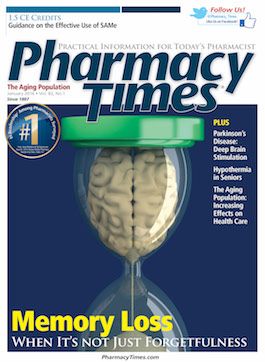Publication
Article
Pharmacy Times
New Year, New Opportunities: Medication Therapy Management for an Aging Patient Population
Author(s):
As health care professionals, we must use every tool we have to streamline patient care while not sacrificing quality of care.
PL is a 74-year-old man who has hypertension, dyslipidemia, and arthritis. PL visited your pharmacy a few weeks ago, and you reviewed all his medications with him during a brown bag session. PL complained about the increasing costs of his medications, and adherence was identified as a challenge due to the financial impact. PL requested additional education and training regarding his overall health and heart issues. His goal is to get active and stay out of the hospital. After consulting with PL and his physician about his current health care plan, you made some suggestions to help modify PL’s medication regimen. PL’s physician appreciated your willingness to help monitor PL’s adherence and health and accepted your suggestions. Today, PL arrives at your pharmacy to participate in a medication therapy management (MTM) session in which you can perform a comprehensive medical review and discuss the modifications to his medication regimen. How do you explain MTM and its benefits to PL?
As health care professionals, we must use every tool we have to streamline patient care while not sacrificing quality of care. This is particularly important in caring for an increasingly aging population suffering from chronic conditions and everyday maladies associated with aging. Brown bag medication consults offer a strong starting point for pharmacists to review a patient’s medications and address questions or concerns, but these consults are only a starting point. When issues are identified through a brown bag consult, the next step is to engage in MTM. MTM is a comprehensive review of a patient’s medication profile that can lead to alternative means of care and positive patient outcomes. MTM enhances the efficiency of the health care system and promotes better health for all patients, particularly older patients who require management of their medical issues and health care goals.
MTM optimizes therapeutic outcomes through counseling of patients on proper medication use and adherence. Pharmacists make recommendations to patients, their prescribers, and their caregivers by reviewing drug regimens. In-service educational programs offered by pharmacists can also be a component of MTM. By helping increase the number of clinical activities provided by the pharmacy team, MTM ensures the affordable, safe, and effective use of medications. The benefits of MTM are particularly advantageous to patients suffering from chronic conditions such as dyslipidemia, hypertension, asthma, and diabetes. As the average age of our population increases, chronic disease states need to be managed for longer periods of an individual’s life. Therefore, the health care system must become more efficient in how it treats the elderly and manages chronic diseases. Insurance companies have advocated promoting MTM for patients who require medication for chronic conditions. MTM creates efficiencies in treating chronic conditions by promoting cost-effective treatments, better understanding of individual patient histories and goals, and education of the pharmacy team on these conditions and how to interact with diverse patient populations. By understanding a disease state and the associated evidence-based guidelines and proper therapy, pharmacists can efficiently review a health care provider’s (HCP’s) work and provide better care to patients.
Initial comprehensive medication reviews can provide insight into a patient’s adherence to long-term regimens and therapy. Patient care can be simplified by reviewing the overall picture of a patient’s medication profile. Using effective charting methods (eg, an SOAP [subjective, objective, assessment, plan] note outline) to concisely document pharmacist—patient interactions allows pharmacists to efficiently share recommendations with the health care team. In addition, a patient’s response to openended questions during interviews and chart reviews may provide opportunities to offer immunizations and screenings. These opportunities can reduce patient reliance on expensive medical alternatives and interventions, as well as allow patients to feel more comfortable with their pharmacist and pharmacy team.
MTM can result in a number of positive outcomes. By incorporating MTM into your work flow, you will see results not only for individual patients but also for your community pharmacy as a whole. Patient satisfaction can help prevent pharmacy shopping (or polypharmacy) and promote loyalty. In turn, patients will benefit from improved medication adherence, which also helps streamline work flow and allows more time for the pharmacy team to provide valuable care. Pharmacists and the pharmacy team are often the primary intermediary between an HCP and a patient. A pharmacy team can interact with a patient several times a month, but an HCP usually sees a patient only at an annual visit or in response to an immediate health care concern. The accessibility of the community pharmacy team provides a unique opportunity for it to apply MTM to better communicate with and treat patients to enhance health care outcomes.
Dr. Drury works as a clinical pharmacy specialist in Chicago, Illinois, and Milwaukee, Wisconsin. She earned her doctor of pharmacy degree from Midwestern University College of Pharmacy. Her blog, Compounding in the Kitchen, an innovative amalgam of pharmacy and cooking, appears on www.PharmacyTimes.com/blogs/compounding- in-the-kitchen. Read, and enjoy!







